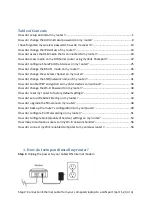
User’s Manual
Enterprise Access Point
ENGLISH
Copyright © 4IPNET, INC. All rights reserved.
90
transmission efficiency. Select
Enable
to use Short Preamble or
Disable
to use Long Preamble with a
128-bit synchronization field.
Short Guard Interval (available when Band is 802.11g+802.11n or 802.11a+802.11n):
The guard
interval is the space between symbols (characters) being transmitted to eliminate inter-symbol
interference. In order to further boost throughput with
802.11n
, short guard interval is half of what it
used to be; please select
Enable
to use Short Guard Interval or
Disable
to use normal Guard Interval.
Channel Width (available when Band is 802.11g+802.11n or 802.11a+802.11n):
Double channel
bandwidth to 40 MHz or 80 MHz to enhance throughput.
Channel:
Select the appropriate
channel
from the drop-down menu to correspond with your network
settings, for example, Channel 1-11 is available in North American and Channel 1-13 in Europe, or
choose the default
6
.
Max Transmit Rate:
The maximum wireless transmit rate can be selected from the drop-down menu.
The system will use the highest possible rate when
Auto
is selected. Please note that MCS0 ~
MCS23 are transmit rates only for n bands.
Transmit Power:
The signal strength transmitted from the system can be selected by Levels. Each
Level signifies a decrement of 1dBm from the highest power.
Level 1
is the actual highest power,
Level 2
is the highest power minus 1dBm, so on and so forth.
ACK Timeout:
It indicates a period of time when the system waits for an Acknowledgement frame
sent back from a station without retransmission. In other words, upon timeout, if the
Acknowledgement frame is still not received, the frames will be retransmitted. This option can be used
to tune network performance for extended coverage. For regular indoor deployments, please keep the
default setting.
Beacon Interval (ms):
The entered amount of time indicates how often the beacon signal will be sent
from the access point.
Airtime Fairness:
Networks often are backward compatible, supporting 802.11b and/or 802.11g
devices. But when these devices occupy airtime, throughput for 802.11n devices is affected. When
enabled, this feature ensures all devices with different band compatibilities have the same air time.
This feature is ideal for networks with devices supporting different bands. When set to
“Preferred
Access
”, N band clients are prioritized. This feature is ideal for networks with devices supporting
different bands.
Packet Delay Threshold (ms):
An Access Point may be occupied trying to transmit a packet to a
busy client or a client out of range, hence delaying transmission to other connected clients. When
Enabled, this Tx queue flushing mechanism drops packets and immediately begins to process others
if the queue has been processed for more than x milliseconds, where Default = 0 (disabled). This
feature improves the performance of complex wireless networks but may require some packets to be
resent.
Idle Timeout (s):
Client disconnects when inactivity reaches the configured amount of time in
seconds, where default = 300s.
Band Steering:
When enabled, clients with 5GHz connectivity will be steered towards the 5GHz band
Содержание EAP210
Страница 1: ...Enterprise Access Point Indoor EAP Series Outdoor OWL Series ...
Страница 33: ...User s Manual Enterprise Access Point ENGLISH Copyright 4IPNET INC All rights reserved 32 OWL620 OWL620 OWL610 ...
Страница 132: ...User s Manual Enterprise Access Point ENGLISH Copyright 4IPNET INC All rights reserved 131 CPE Mode Main Page ...
Страница 147: ...User s Manual Enterprise Access Point ENGLISH Copyright 4IPNET INC All rights reserved 146 ...
Страница 158: ...User s Manual Enterprise Access Point ENGLISH Copyright 4IPNET INC All rights reserved 157 ...
Страница 159: ...User s Manual Enterprise Access Point ENGLISH Copyright 4IPNET INC All rights reserved 158 ...
















































